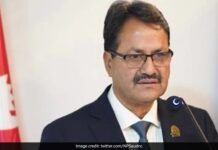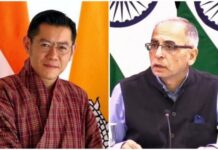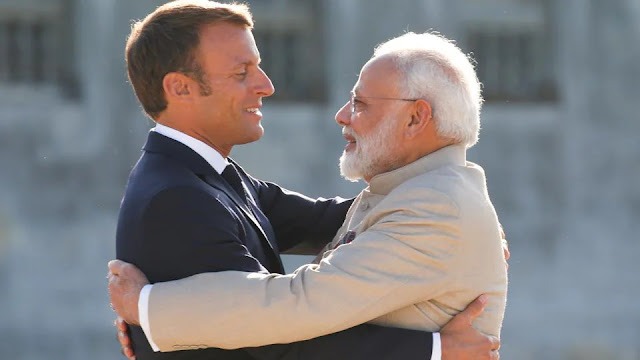Nobody, not even the best soothsayers or experts, can explain why the world is suddenly changing so quickly, but remember the prophesy once sung by Bob Dylan, it seems to become true, “For the times, they are a-changin’”.
A sign of the changing time, France has a new prime minister, 34 years of age of a different sexual orientation as the head of the government.
Who could have imagined this a few years ago?
Of course, in India is difficult to understand that such a young ‘inexperienced’ leader, could lead a country with multiple problems, but how old were Adi Shankara or Swami Vivekananda when they changed India in so much depth.
One can’t compare the new French leader to the two above mentioned spiritual giants, but one can hope that fresh blood will be good for France in these ‘changing’ times.
Macron back in India
In the meantime, the French President Emmanuel Macron will be Chief Guest for Republic Day.
I still remember his last State visit in March 2018; addressing a French gathering in Delhi, the President spoke of the Chinese hegemony in the region and said that France was ready to work with India on the oceans: “France is a power of the Indian and the Pacific Oceans; we are present at the Reunion, we are also there in French Polynesia and New Caledonia. And we are a maritime power, it is often forgotten but France is the second maritime power in the world. We have a strong navy, we have nuclear submarines equipped like few other powers in the world; a maritime surveillance capability through our own satellites and technologies; it is obvious we are a military and intelligence power ranking us among the first nations in the world.”
This language was surprising at that time, but one can measure how much the world has changed and particularly the great powers’ views on the Middle Kingdom in the post-Covid era (and post-Eastern Ladakh confrontation for India).
Many more countries have today realized that China can’t be left free to engulf the oceans around.
Twenty Five Years of Strategic Partnership
The 90’s saw a a tremendous boost in bilateral relations with the visits of President Chirac in January 1998 and Prime Minister Atal Bihari Vajpayee’s trip to Paris later in the year (incidentally, the new French prime minister is Mr. Attal, with two ‘t’, though the French will not pronounce differently)..
The most striking feature of 1998’s visit was the setting up of a framework for a strategic partnership.
Using a de Gaulle-like language, Jacques Chirac saluted India, “a nation which has affirmed its personality on the world stage”. He said that he had come to show that “France wanted to accompany India in its potent march [towards the future].”
Chirac’s words were not mere political niceties.
When India conducted its nuclear tests in Pokhran in May, France was one of the few countries which did not condemn Delhi (or impose sanctions). This was greatly appreciated in Delhi and when Prime Minister Vajpayee returned Chirac’s visit in October, the new strategic dialogue could take its first concrete steps.
These events set in motion a closer collaboration.
The Deals
The French government has recently submitted a response to India’s Rs 50,000 crore tender to purchase 26 Rafale Marine fighter jets for the Indian Navy; according to India Today: “India has initiated the USD 6 billion deal with France for the acquisition of 26 Rafale Marine aircraft, aiming to enhance the Indian Navy’s aircraft carrier capabilities.”
The purchase of three new Scorpene submarines is also in the pipeline.
These deals are expected to be soon finalized.
Reciprocal Collaboration
The collaboration between France and India is multiple and reciprocal. For example, the Paris Region of France is calling for more investments from India.
Valérie Pécresse, President of the Paris Region, recently met Reliance Industries Chairman Mukesh Ambani and Tata Sons chief N Chandrasekaran in Mumbai and asked the Indian entrepreneurs to invest in her region. Pécresse told media: “We are on a charm offensive to win hearts and minds of Indian students, tourists, investors and film makers.”
Today Indians represent fraction of the 50 million tourists visiting Paris; for example, figures say that the number of Australians and Chinese visiting the French capital is far higher than Indians.
Local Collaboration
The collaboration is today getting delocalized. France recently set up an exclusive pavilion at the third edition of the Tamil Nadu Global Investors Meet (GIM), a two-day event from January 7, whose objective was to foster economic ties with India. The Consulate of France in Puducherry and Chennai coordinated the French participation; France was a country partner for the event. The French Pavilion showcased many Paris-based companies including Michelin, Precia Molen, Valeo, Cryolar and Numeric among others.
A communiqué explained: “France is a major source of foreign direct investment for India with more than 1,000 French establishments already present in the country. Tamil Nadu, boasting the second largest economy in India with a Gross State Domestic Product (GSDP) exceeding USD 300 billion, stands out as India’s most industrialised state, housing over 130 Fortune 500 companies.”
Student Exchange: the Future
Last July 14, during his visit as guest of honour of France during the National Day, Prime Minister Modi among other announcements, mentioned bilateral cooperation, research and higher education. He announced that Paris has accepted to welcome in France 20,000 Indian students by 2025 and 30,000 by 2030.
A roadmap said that the cooperation will be centered on ‘a union of forces’; it will make “sciences, technologic innovation and university cooperation [the] vectors for progress and independence for our two countries”.
A chapter of the roadmap is dedicated to ‘human partnerships’.
France and India are “determined to develop their university bonds and encourage exchanges between students”.
To give a concrete shape to the project, Mumbai University (MU) has decided to join hands with a French university for dual degree program. Students will have to spend six to nine months in France at the University of Troyes on fellowship training as per the dual degree program.
According to a MU communiqué: “The combined expertise from both institutions may lead to potentially groundbreaking research outcomes in nanoscience and nanotechnology. Students enrolling with the Department of Nanoscience and Nanotechnology at MU for postgraduation (PG) will now get dual degree — jointly awarded by the MU and the University of Technology of Troyes in France.”
The Ideal Partners?
During Macron’s 2018 visit, Prime Minister Narendra Modi spoke of “Five S”, Samman (respect); Samvad (dialogue); Sahayog (cooperation), Shanti (peace), and Samriddhi (prosperity). Paris certainly still agrees with this.
Today, most commentators converge to say that France and India are the ideal partners; in US-based The National Interest, Don McLain Gill wrote: “Among Western countries, France has often been the first to illustrate a mature understanding of India’s position on varied issues ranging from nuclear tests to the ongoing Russia-Ukraine War.”
Shishir Gupta said in The Hindustan Times: “PM Modi and Macron share a very close chemistry. They often talk to each other about major positions. …When Macron comes to India, the centerpiece will be Atmanirbhar Bharat.”
Gupta mentions the joint research and development of small modular nuclear reactors: “These are nuclear reactors that produce less than 300 megawatts. These reactors are fundamental to nuclear energy. They are also fundamental to the green hydrogen project.”
Joint Development
After 25 years of ‘partnership’ India and France have reached an unparalleled level of trust and proximity; this should translate into something not easy to do, even for European partners, i.e. joint developments in new fields of science or technology.
Already public sector giant Hindustan Aeronautics Limited (HAL) has opened a new design and test facility at its Aero Engine Research and Development Centre (AERDC) in Bengaluru which will be used to test helicopter engines to be co-developed between the French firm Safran and HAL; the engine is to be fitted in the new 13-tonne Indian Multi-Role Helicopter (IMRH), which will replace the Russian Mi-17 helicopters.
In February 2023 HAL and Safran had announced a tie-up to produce the engine for the 13-ton helicopter; HAL will participate in the design, development and production of the core engine components. Safran already has a joint venture with HAL to manufacture engines for the advanced light helicopter (ALH), weighing 5.5 tonnes.
Apart from the dream to develop together an engine for the Indian jets, high-tech drones could be another field of future collaboration. Recently, the Indian Navy received its first indigenous medium-altitude long-endurance (MALE) drone, an unmanned aerial vehicle (UAV) built by Adani Defence and Aerospace at its Hyderabad facility (with Israeli transfer of technology).
Why can’t Paris and Delhi decide to develop the drones of tomorrow? Not an easy proposal, but perhaps worth trying.
































